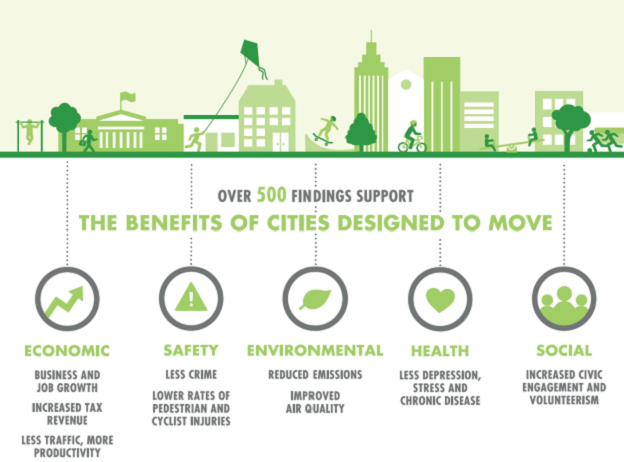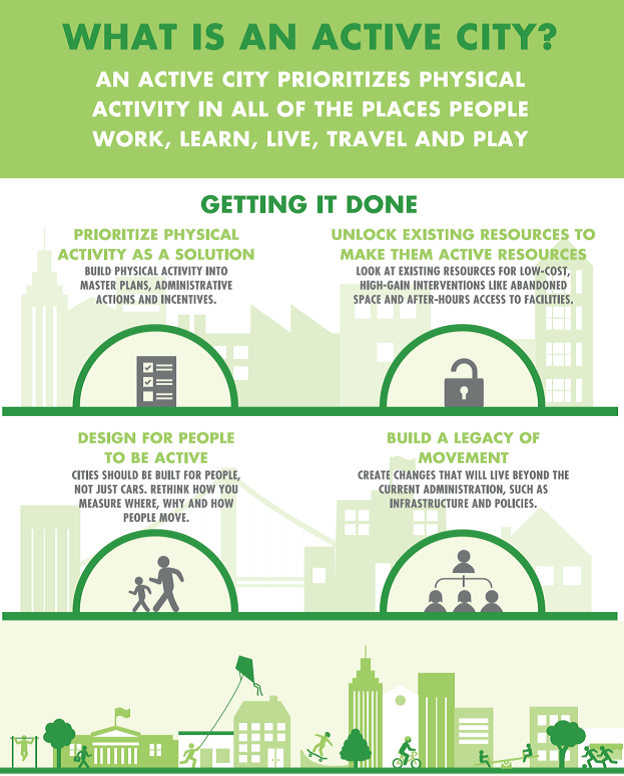The "Active Cities Report" by the Designed to Move coalition provides detailed guidance concerning how to integrate physical activity into community design, and information on the economic, social and environmental benefits that result.

Designed to Move is a coalition of more than 80 public, private, and civil sector organizations dedicated to ending the growing epidemic of physical inactivity. Their newest report, Active Cities: A Guide for City Leaders, provides detailed information concerning why and how to incorporate healthy physical activity into community design.

The report explains:
This is about making our cities more competitive.
The research is clear on this claim. Integrating physical activity into the places we work, live, learn, travel, and play is the only way to ensure we move enough to thrive.
Physical inactivity is bankrupting economies at the national level, but it is felt most acutely by the world's cities—often through negative impacts on the health of people, economies, and the environment. This is bad news for cities and their citizens. The good news is there's a solution.
Our bodies are designed to move. Our cities should be too.
Higher levels of physical activity are associated with positive outcomes for most of the things that matter to city leaders. When people move more, crime, pollution, and traffic go down. Productivity, school performance, property values, health, and well-being improve drastically.
Cities that make physical activity a priority, convert existing spaces into active spaces, and design environments for people to be active will create a legacy of physical activity. These active cities will be better off by almost every possible measure.
Our purpose here is to provide a blueprint for creating active cities, whatever their size and wherever in the world they may be.

This report is based on an extensive body of academic research described in the article, "Co-benefits of Designing Communities for Active Living: An Exploration of Literature," written by a team lead by Dr. James F Sallis, recently published in the International Journal of Behavioral Nutrition and Physical Activity.
FULL STORY: Active Cities Report - A Guide for City Leaders

Planetizen Federal Action Tracker
A weekly monitor of how Trump’s orders and actions are impacting planners and planning in America.

Chicago’s Ghost Rails
Just beneath the surface of the modern city lie the remnants of its expansive early 20th-century streetcar system.

Amtrak Cutting Jobs, Funding to High-Speed Rail
The agency plans to cut 10 percent of its workforce and has confirmed it will not fund new high-speed rail projects.

The French Solution to Congested Tunnels: Make Them Car-Free
Bay Area transportation officials keep expanding car capacity. Lyon’s Croix Rousse Tunnel offers a different way.

Missouri Governor Reverses Anti-Discrimination Housing Policies
A new state law bars cities from prohibiting source-of-income discrimination against tenants using Section 8 housing vouchers.

USDOT Launches Unfunded 'SAFE ROADS' Program
The program targets “distractions” and “political messages or artwork,” and paves the way for autonomous vehicles.
Urban Design for Planners 1: Software Tools
This six-course series explores essential urban design concepts using open source software and equips planners with the tools they need to participate fully in the urban design process.
Planning for Universal Design
Learn the tools for implementing Universal Design in planning regulations.
City of Fort Worth
planning NEXT
Mpact (founded as Rail~Volution)
City of Camden Redevelopment Agency
City of Astoria
City of Portland
City of Laramie





























